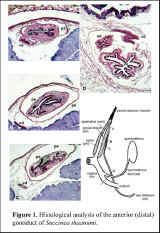|
We
have undertaken anatomical analysis of 19 Hawaiian species of succineids.
Data collection and analysis of conchological characters has been carried
out for over 200 specimens representing a variety of Hawaiian taxa,
including type specimens from the collections at the Bishop Museum in
Honolulu.
Soft
Anatomy
Figure 1
illustrates one of the primary character sets, the distal reproductive
system, in this case of Succinea
thaanumi from the
island
of
Hawaii.
The diagram at the bottom right of Figure 1 is a schematic of the anterior
(distal) gonoduct of Succinea
thaanumi, from an anterior view. The slices through the gonoduct
marked A through D correspond to the histological sections, figures A
through D. In figures A through C, clustered purple or dark material at
the bottom of each section is part of the coiled mucus glands along the
oviducal portion of the gonoduct.
 Figure 1A
shows a section through the uppermost posterior portion of the penial
sheath as it passes close to the dorsal body wall. The open space in the
section is the penial sheath, containing a cross-section through the
epiphallus, with the vas deferens just external to the penial sheath on
the lower left. The epiphallus has a muscular wall and folded internal
lumen with some mucoid secretory cells. The vas deferens is non-muscular
with a narrow duct. Figure 1A
shows a section through the uppermost posterior portion of the penial
sheath as it passes close to the dorsal body wall. The open space in the
section is the penial sheath, containing a cross-section through the
epiphallus, with the vas deferens just external to the penial sheath on
the lower left. The epiphallus has a muscular wall and folded internal
lumen with some mucoid secretory cells. The vas deferens is non-muscular
with a narrow duct.
Figure 1B
shows a cross-section through the posterior region of the penial sheath,
where the epiphallus and penis are separated. The penis and epiphallus are
both muscular. The penis has a Y-shaped lumen, and the epiphallus at this
point has a simple lumen with some mucoidal secretory cells. The vas
deferens is a thin-walled duct to the lower left. An interesting
characteristic (perhaps species-specific) is the extension of the penial
lumen past its junction with the epiphallus.
Figure 1C
is a cross-section through the penial sheath and penis. The penis in this
section is muscular, with a deeply folded lumen. The vas deferens is a
narrow thin-walled duct to the lower left.
Figure 1D
is more ventral in the body, and is a section through the vagina, or
anterior oviduct. The oviduct itself is deeply folded without a thick
layer of muscle, and the lumen is nonglandular. The spermathecal duct,
x-shaped in cross-section, is above left, and the vas deferens, cut on an
angle, is above right.
|